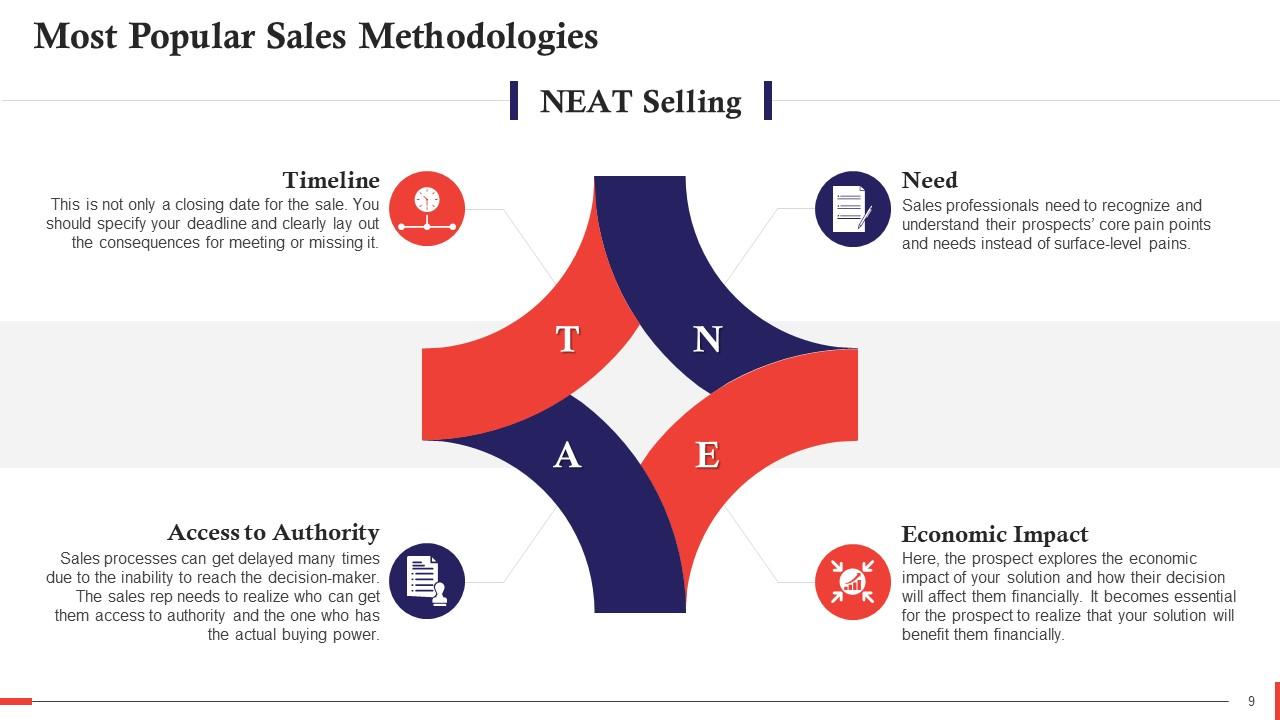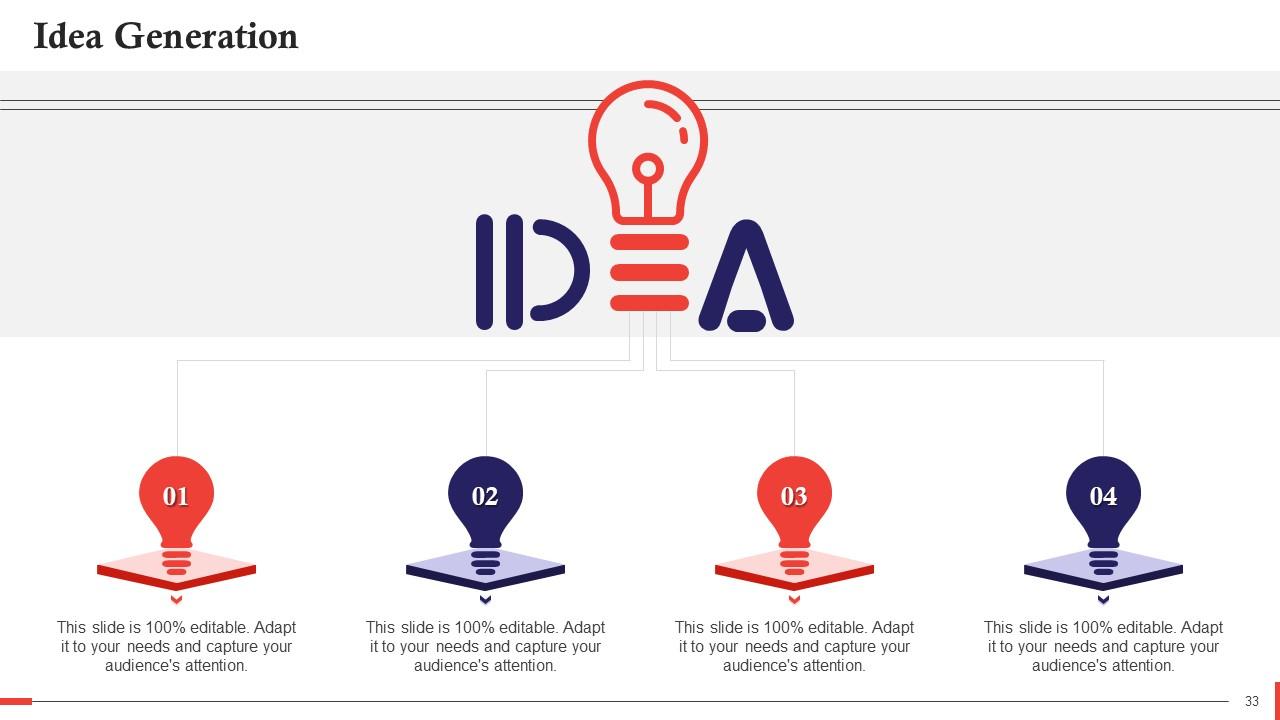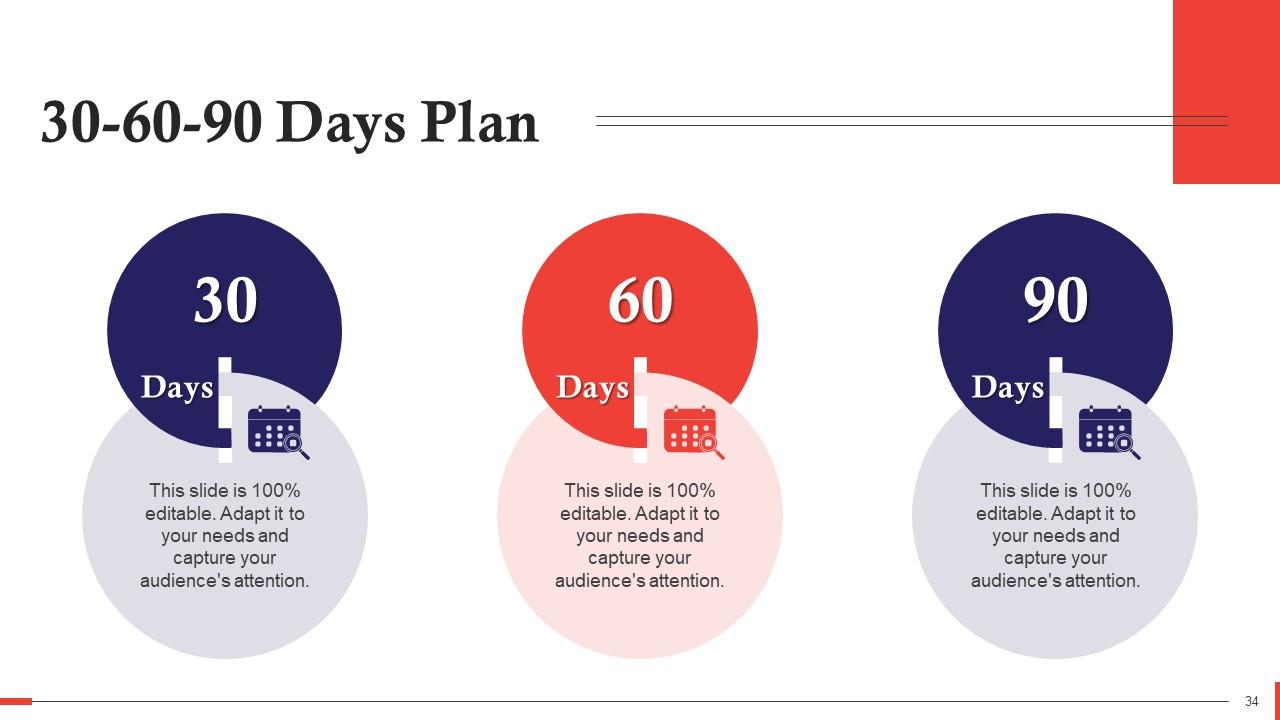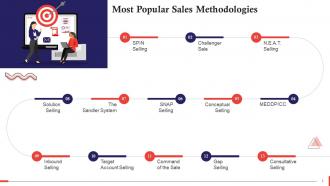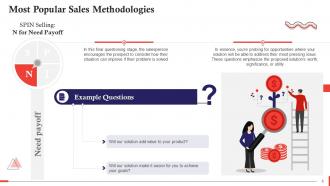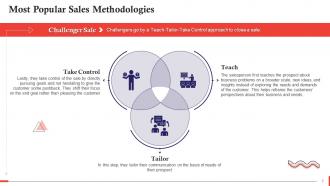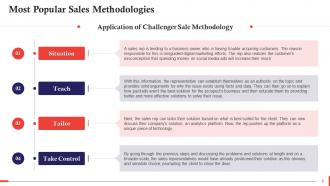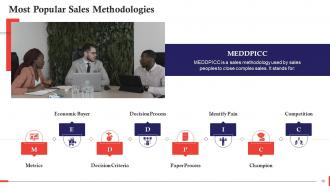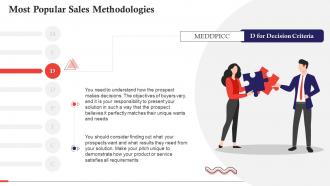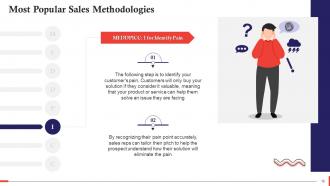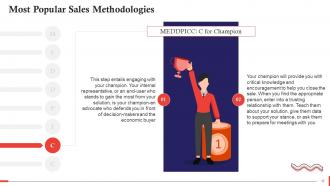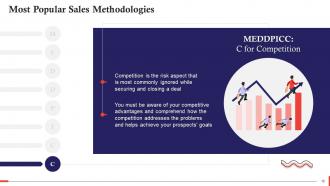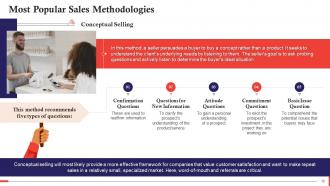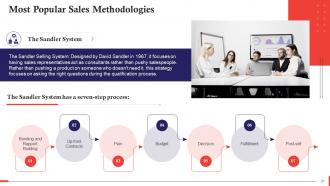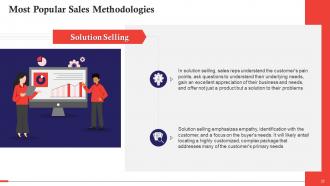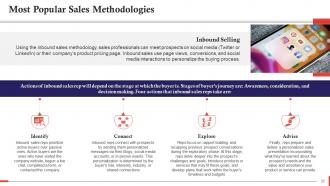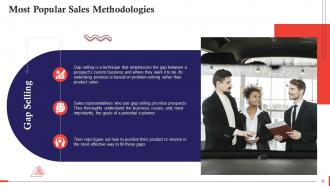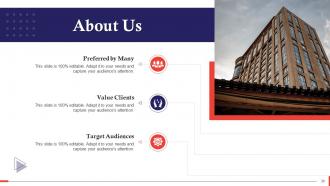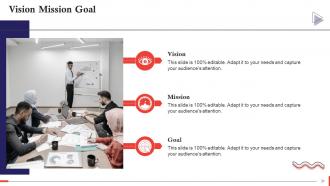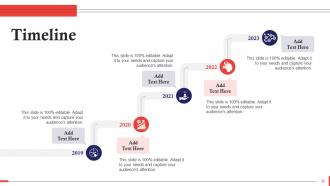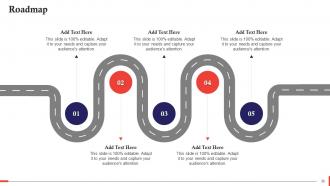A Guide To Sales Methodologies Training Ppt
These slides present the best sales methodologies that salespeople can use. The methodologies are SPIN selling, challenger sale, N.E.A.T. selling, MEDDPICC, conceptual selling, snap selling, the Sandler system, solution selling, inbound selling, target account selling, command of the sale, gap selling, and consultative selling.
You must be logged in to download this presentation.
 Impress your
Impress your audience
Editable
of Time
PowerPoint presentation slides
Presenting A Guide to Sales Methodologies. These slides are 100 percent made in PowerPoint and are compatible with all screen types and monitors. They also support Google Slides. Premium Customer Support available. Suitable for use by managers, employees, and organizations. These slides are easily customizable. You can edit the color, text, icon, and font size to suit your requirements.
People who downloaded this PowerPoint presentation also viewed the following :
Content of this Powerpoint Presentation
Slide 1
This slide lists the best sales methodologies that salesperson can use. The methodologies are: SPIN selling, challenger sale, N.E.A.T. selling, MEDDPICC, conceptual selling, snap selling, the Sandler system, solution selling, inbound selling, target account selling, command of the sale, gap selling, and consultative selling.
Slide 2
This slide gives an introduction to SPIN selling methodology to close complex sales. SPIN stands for the four stages of question sequences a salesperson should ask a prospect. These are situation, problem, implication, and need payoff.
Slide 3
This slide highlights the importance of Situation stage in SPIN selling. The aim behind the questioning sequence in this stage is to learn about and understand your prospect’s perspective.
Slide 4
This slide highlights the importance of Problem Stage in SPIN selling. In this stage, the aim is to get to the core of the prospect's issue. Sales representatives try to identify areas of potential opportunity and issues that the prospects may be unaware of or dissatisfied with.
Slide 5
This slide highlights the importance of Implication Stage in SPIN selling. In this stage, the salesperson encourages the prospect to consider the consequences of not solving the problem.
Slide 6
This slide highlights the importance of Need Payoff Stage in SPIN selling. In this final questioning stage, the salesperson encourages the prospect to consider how the situation can improve if their problem is solved.
Slide 7
This slide gives an introduction to a Challenger Sale for closing sales with complex customers. In this methodology, challengers go by a Teach-Tailor-Take Control approach to close a sale.
Slide 8
This slide shows an example of how to close a complex deal using the challenger sale methodology. The situation entails a problem of acquiring customers. The sales rep disagrees with the solution the client thinks would be best for them. The sales rep then goes on to explain how their solution will be a better suit for their business supporting it through facts and data. The sales rep will be able to close the deal based on his domain knowledge and confidence rather than by pleasing the customer
Slide 9
This slide depicts the NEAT selling methodology for closing sales with complex customers. NEAT is an abbreviation for Needs, Economic Impact, Access to Authority, and Timeline. It discusses the importance of understanding the customers’ core pain points, and making them understand how your solution will benefit them financially. NEAT also allows the sales rep to identify the person with actual buying power and help set a timeline for the sale.
Slide 10
This slide showcases the MEDDPICC sales methodology to close sales with complex customers. It stands for Metrics, Economic Buyer, Decision Criteria, Decision Process, Paper Process, Identify Pain, Champion, and Competition.
Slide 11
This slide highlights the importance of M or Metrics in MEDDPICC selling. Metrics is the quantifiable data, or actual numbers and KPI improvements that your prospect wishes to achieve. Make sure you identify all benefits and amount of improvement your solution brings to the table to increase its appeal for the customer.
Slide 12
This slide talks about the importance of E or Economic Buyer in MEDDPICC selling. The final decision-maker is the economic buyer, so it is essential to meet them as early as possible in the sales process since they are the ones that sign the final contract and make purchasing decisions for the organization.
Slide 13
This slide highlights the importance of D or Decision Criteria in MEDDPICC selling. You need to understand how the prospect makes decisions. The objectives of buyers vary, and it is your responsibility to present your solution in such a way that the prospect believes it perfectly matches their unique wants and needs.
Slide 14
This slide talks about the importance of D or Decision Process in MEDDPICC selling. The Decision Process gives you information about your prospect company's decision-making process. You should gather all sorts of information like who is to be present in the meeting, what paperwork is required, insights about the approval process, etc.
Slide 15
This slide highlights the importance of P or Paper Process in MEDDPICC selling. A clear understanding of the paper process can help the sales rep make better decisions during the sales process and make more accurate predictions, increasing the chance of closing the deal.
Slide 16
This slide talks about the importance of I or Identify Pain in MEDDPICC selling. Customers will only buy your solution if they consider it valuable, meaning that your product or service can help them solve an issue they are facing. By recognizing their pain points accurately, sales reps can tailor their pitch to help the prospect understand how their solution will eliminate the pain.
Slide 17
This slide highlights the importance of C or Champion in MEDDPICC selling. This step entails engaging with your champion. Your internal representative, or an end-user who stands to gain the most from your solution, is your champion—an advocate who defends you in front of decision-makers and the economic buyer.
Slide 18
This slide talks about the importance of C or Competition in MEDDPICC selling. Competition is the risk aspect that is most commonly ignored when securing and closing a deal. You must be aware of your competitive advantages and comprehend how the competition addresses the problems and helps achieve your prospects' goals.
Slide 19
This slide talks about conceptual selling, a sales methodology. It highlights that in this method, a seller persuades a buyer to buy a concept rather than a product. It seeks to understand the client's underlying needs by listening to them. It also mentions that here the sellers’ goal is to ask probing questions and actively listen to determine the buyer's ideal situation.
Slide 20
This slide provides information about SNAP (Simple, iNvaluable, Aligned, and Priority), a sales methodology. SNAP assumes that customers have little time to decide and are frequently overwhelmed with information when they contact a representative. The methodology is based on the idea that a representative can assist the customer by keeping things simple and providing only the necessary information.
Slide 21
This slide discusses Sandler selling, a sales methodology. It highlights that The Sandler Selling System designed by David Sandler in 1967, focuses on having sales representatives act as consultants rather than pushy salespeople. Rather than pushing a product on someone who doesn't need it, this strategy focuses on asking the right questions during the qualification process.
Instructor’s Notes: The Sandler System has a seven-step process:
- Bonding and Rapport Building: The first step in relationship building is establishing a bond and rapport with your prospect, which should encourage open and honest communication
- Up-front Contracts: Establishing roles and expectations is the second step in the relationship-building process. During this stage, establish ground rules and create a welcoming environment for conduct of business
- Pain: This section of the conversation will assist you in identifying the prospect's pain points and how your product or service can help them
- Budget: Sandler Selling System discusses the budget during the qualification phase. According to the Sandler System, selling your product to someone who can't afford it is pointless. The sales rep determines whether or not your prospect is willing and able to invest the time, money, and resources required to solve their problem during this stage of the qualification process
- Decision: The qualification phase concludes with a discussion of the decision-making process. Determine who, what, where, why, and how the prospect wants the purchasing process to proceed
- Fulfillment: In this final stage, the sales rep proposes their product or service as a solution to the prospect's problem. Your proposal will address their concerns, particularly regarding the budget and the decision-making process
- Post-sell: It is eventually time to close the deal quickly, before competition can step in
Slide 22
This slide discusses solution selling, a sales methodology. It highlights that in solution selling, sales reps understand the customer's pain points, ask questions to understand their underlying needs, have an excellent appreciation of their business and needs, and offer not just a product but a solution to their problems.
Slide 23
This slide discusses inbound selling, a sales methodology. It highlights that using the inbound sales methodology, sales professionals can meet prospects on social media (Twitter or LinkedIn) or their company's product pricing page. Inbound sales use page views, conversions, and social media interactions to personalize the buying process.
Slide 24
This slide discusses target account selling, a sales methodology. It highlights that target account selling is selecting or engaging with the right prospects, paying close attention to them, and conducting extensive research while creating buyer personas, lead qualifications, and mapping organizations.
Slide 25
This slide discusses command of the sale, a sales methodology. It highlights that selling with urgency and extensive product knowledge is part of the command of the sale methodology. It also states that a salesperson must be able to define how their product/service solves the pains, needs, and interests of their prospects in ways that their competitors cannot.
Slide 26
This slide discusses gap selling, a sales methodology. It highlights that gap selling is a technique that emphasizes the gap between a prospect's current business and where they want it to be. Its underlying premise is based on problem-solving rather than product sales. It also mentions that prospects are prioritized by sales representatives who use gap selling. They thoroughly understand the business, issues, and, most importantly, the goals of a potential customer.
A Guide To Sales Methodologies Training Ppt with all 42 slides:
Use our A Guide To Sales Methodologies Training Ppt to effectively help you save your valuable time. They are readymade to fit into any presentation structure.
-
I am glad to have come across Slideteam. I was searching for some unique presentations and templates for my business. There are a lot of alternatives available here.
-
The designs are very attractive and easy to edit. Looking forward to downloading more of your PowerPoint Presentations.











